Looking for a nourishing, flavor-packed meal that checks all the boxes—healthy, customizable, and meal-prep friendly? The Mediterranean Grain Bowl with Roasted Veggies and Hummus is your new go-to. Packed with whole grains, vibrant vegetables, creamy hummus, and topped with Mediterranean favorites like feta and olives, this bowl delivers bold taste and balanced nutrition in every bite. Whether you’re plant-based, flexitarian, or just looking to eat more veggies, this guide will help you build the perfect grain bowl every time.
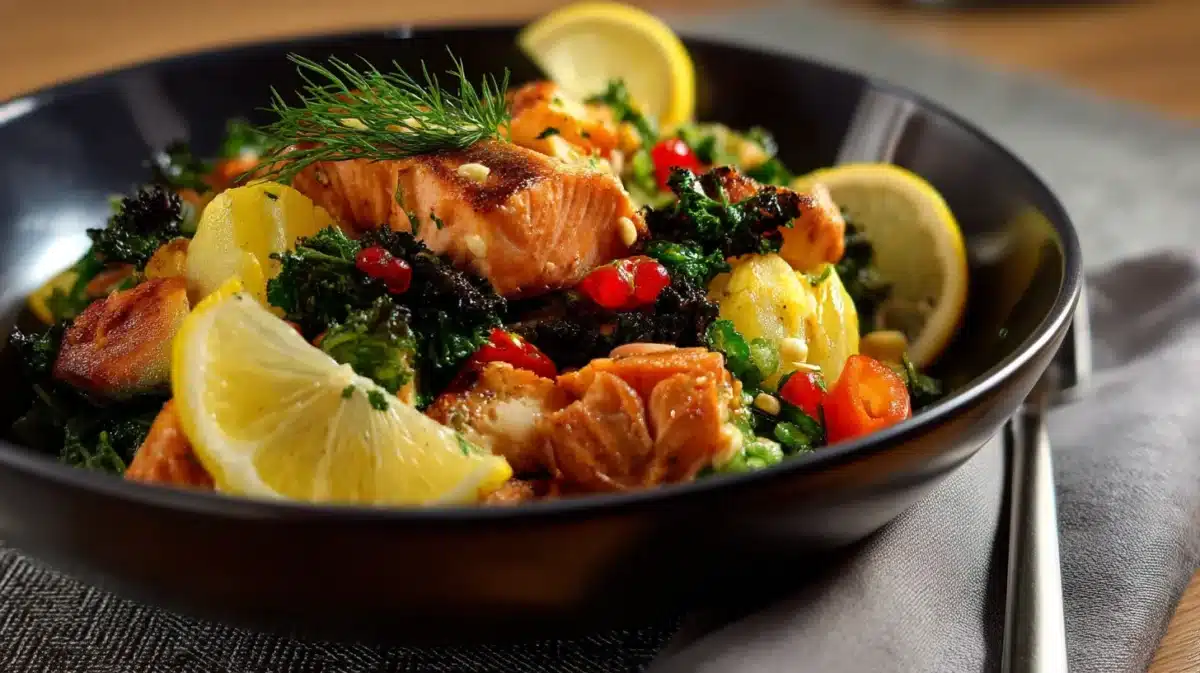
Don’t miss our Mediterranean Quinoa Breakfast Bowl for another wholesome variation.
PART 1: Why Mediterranean Grain Bowls Are the New Supermeals
What Makes Mediterranean Bowls Nutritionally Complete?
A Mediterranean grain bowl with roasted veggies and hummus isn’t just a feast for the eyes—it’s a complete meal offering complex carbs, healthy fats, protein, and fiber. The Mediterranean diet, often hailed as one of the healthiest in the world, emphasizes fresh produce, legumes, whole grains, and heart-healthy fats. Bowls built on this framework support heart health, digestion, and long-lasting energy.
Key nutrients in a Mediterranean bowl:
| Component | Nutrient Highlight | Example Ingredient |
|---|---|---|
| Whole Grains | Fiber, B-vitamins | Quinoa, farro, brown rice |
| Roasted Vegetables | Antioxidants, Vitamins A & C | Zucchini, eggplant |
| Hummus | Plant-based protein, Iron | Chickpeas, tahini |
| Toppings | Omega-3s, Calcium | Feta, olives, nuts |
This balanced plate is ideal for anyone seeking anti-inflammatory meals or trying to manage weight while still enjoying delicious food.
Benefits of a Plant-Forward Mediterranean Lifestyle
Embracing a plant-forward approach—focusing more on vegetables, grains, and legumes—is not just a trend. Studies consistently link Mediterranean-style eating with lower risks of chronic illness, improved gut health, and better mental well-being. Grain bowls rich in roasted veggies and hummus align perfectly with these findings.
Unlike diet fads that restrict food groups, the Mediterranean lifestyle encourages variety. You can enjoy the earthy sweetness of roasted carrots or the creamy goodness of garlic hummus while still hitting your nutrition goals.
Discover great ideas like Mediterranean Charred Broccoli Recipe to diversify your bowl.
PART 2: Key Ingredients for a Perfect Grain Bowl
Choosing the Right Grains: Quinoa, Brown Rice, or Farro?
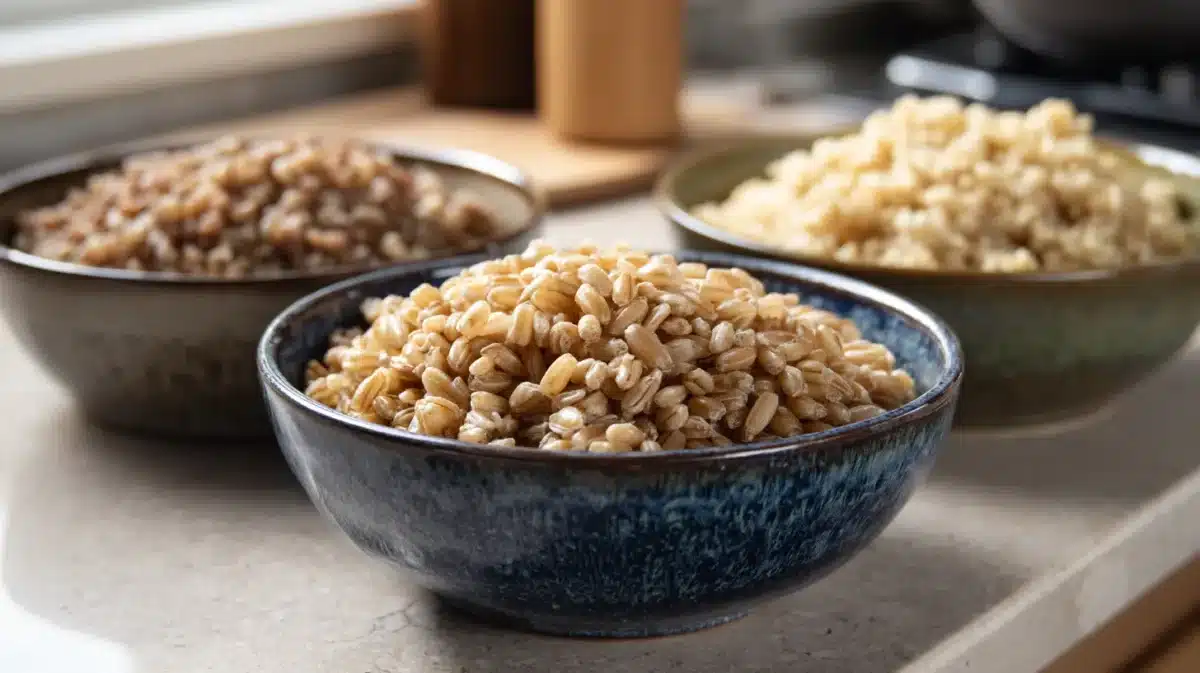
When crafting a standout Mediterranean grain bowl with roasted veggies and hummus, your grain base sets the tone. Each grain brings its own texture, flavor, and nutritional profile to the table:
| Grain | Texture | Nutritional Highlights | Cooking Time |
|---|---|---|---|
| Quinoa | Fluffy, nutty | High in protein, gluten-free, iron-rich | ~15 minutes |
| Brown Rice | Chewy | Fiber-rich, widely accessible | ~40 minutes |
| Farro | Hearty, firm | High in magnesium, protein, and fiber | ~30 minutes |
Quinoa is perfect if you’re after a gluten-free grain bowl, while farro offers that chewy bite Mediterranean dishes are known for. These grains act as the nutritional foundation—delivering slow-digesting carbs, fiber, and essential micronutrients that pair beautifully with creamy hummus and roasted vegetables.
For extra flavor, try cooking your grains in vegetable broth and finishing them with a drizzle of lemon juice or a pinch of za’atar.
Looking for inspiration? Try Costco Mediterranean Salad Recipe as a tasty base idea.
Best Roasted Vegetables for Texture and Flavor
Roasted vegetables transform a simple bowl into a Mediterranean feast. They bring caramelized flavor, fiber, and a hearty texture that complements soft grains and smooth hummus. Aim for a mix of color and variety to maximize both visual appeal and nutritional value.
Top roasted veggie picks for Mediterranean bowls:
- Red bell peppers – sweet, high in Vitamin C
- Zucchini or summer squash – mild and tender
- Eggplant – rich in antioxidants like nasunin
- Cauliflower – adds bite and roasts well
- Brussels sprouts – crispy when roasted with olive oil
Toss your veggies with extra virgin olive oil, garlic, sea salt, and herbs like oregano or thyme. Roast at 400°F until they’re golden and fork-tender.
For a balanced plant-based bowl, aim for a 1:1 grain-to-veggie ratio. This keeps the dish satisfying without overwhelming with carbs, making it a great choice for anyone exploring vegan Mediterranean meals or following a whole food lifestyle.
Check out Cucumber Tomato Mediterranean Salad for a refreshing bowl-friendly topper.
Ingredient Pairing Tip:
Pair roasted vegetables like cauliflower or Brussels sprouts with garlic hummus for an umami-rich bite. Add cooked grains like bulgur or spiced quinoa underneath to soak up those savory juices.
This balance of grains + vegetables + hummus makes the Mediterranean grain bowl not just filling but incredibly satisfying—perfect for clean eating, meal prepping, or an easy weeknight dinner.
Don’t miss our Taylor Farms Mediterranean Salad for more vibrant ingredient combos.
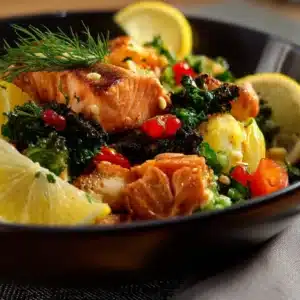
Mediterranean Grain Bowl with Roasted Veggies and Hummus: The Ultimate Guide
Ingredients
- 1 cup cooked quinoa or farro
- 1 cup roasted vegetables carrots, bell peppers, zucchini
- ¼ cup hummus
- ½ cup cherry tomatoes halved
- ¼ cup crumbled feta optional
- 1 tbsp olive oil
- Lemon wedges herbs for garnish
Instructions
- Cook grains according to package instructions.
- Roast vegetables at 400°F for 25–30 minutes with olive oil and herbs.
- Layer grains, then roasted veggies, then hummus and fresh toppings.
- Drizzle with dressing and serve with lemon wedges.
Notes
Vegan if feta is omitted
Gluten-free if using quinoa or brown rice
Nutrition (Estimate):- Calories: 475
- Protein: 16g
- Carbs: 58g
- Fat: 17g
PART 3: The Role of Hummus in a Mediterranean Bowl
Why Hummus Is a Superfood Staple
No Mediterranean grain bowl with roasted veggies and hummus is complete without its creamy, flavorful heart: hummus. This Middle Eastern staple brings far more than taste to the table—it’s a nutritional powerhouse packed with plant-based protein, fiber, and healthy fats.
Hummus is traditionally made from chickpeas, tahini (ground sesame seeds), lemon juice, garlic, and olive oil. Each of these ingredients carries significant benefits:
| Ingredient | Benefit |
|---|---|
| Chickpeas | High in protein and fiber |
| Tahini | Rich in calcium and healthy fats |
| Lemon Juice | Adds vitamin C and brightness |
| Olive Oil | Heart-healthy monounsaturated fats |
Adding just ¼ cup of hummus can boost your grain bowl’s protein by 5–6 grams while also making every bite smoother and more satisfying. Plus, hummus helps tie together the grains and roasted vegetables, acting almost like a creamy dressing without added sugar or preservatives.
This makes it an ideal choice for those following anti-inflammatory meals or looking to increase their intake of vegan protein sources.
Don’t miss our Mediterranean Tomato Cucumber Salad for a cool contrast to creamy hummus.
Hummus Flavor Variations to Elevate Your Bowl
One of the best things about hummus is its versatility. You can stick with the classic or experiment with bold, savory flavors that complement your roasted veggies:
- Roasted Red Pepper Hummus: Adds sweetness and smoky flavor
- Garlic Hummus: Pairs beautifully with Brussels sprouts or eggplant
- Spicy Harissa Hummus: Great for a Tunisian twist
- Herbed Hummus: Infused with basil or parsley for a fresh kick
If you’re going full DIY, blending your own hummus takes under 10 minutes and lets you control salt, spice, and texture. Homemade hummus also allows you to swap in white beans or lentils for a twist on tradition—perfect for high-protein vegetarian meals.
When building your bowl, spread a spoonful of hummus directly on the grain base or dollop it on top. For even more Mediterranean flair, try layering it beneath the veggies, allowing the warm roasted flavors to gently melt into the hummus.
Discover great ideas like Greek Chicken Lemon Rice for protein-packed toppings that pair well with hummus.
PART 4: Step-by-Step Guide to Building Your Mediterranean Grain Bowl
Prep, Roast, and Layer: Cooking Timeline
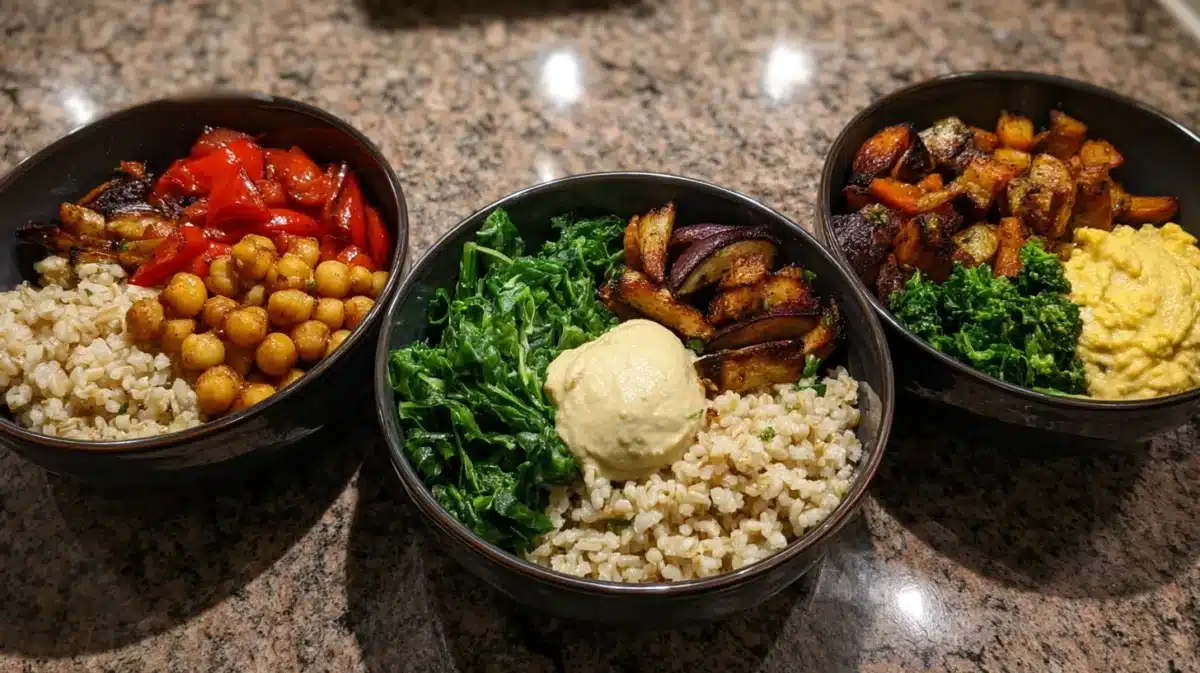
Crafting the perfect Mediterranean grain bowl with roasted veggies and hummus is easier than it sounds. The key is sequencing your prep so every component comes together smoothly and nothing turns soggy or cold.
Here’s a foolproof cooking timeline:
1. Cook your grain base first
Start with farro, quinoa, or brown rice. Use broth instead of water and add a bay leaf or a clove of garlic while it simmers for added Mediterranean flavor.
2. Roast your veggies
Preheat your oven to 400°F. Chop vegetables into uniform sizes so they roast evenly. Toss in olive oil, sea salt, and herbs. Roast for 25–30 minutes, flipping halfway.
3. Prepare cold toppings and hummus
While veggies roast, slice cucumbers, crumble feta, and prepare hummus. If making it fresh, blend chickpeas, tahini, lemon juice, garlic, and a bit of cold water until smooth.
4. Assemble your grain bowl
In a wide bowl, layer warm grains on the bottom. Top with roasted vegetables, dollops of hummus, fresh toppings (like tomatoes or olives), and a drizzle of lemon or tahini sauce.
Assembly Order Tip:
- Grains
- Roasted Veggies
- Hummus
- Fresh toppings
- Sauce & Garnish
This layered approach not only keeps textures intact but also maximizes flavor in every bite—especially when you’re building vegan Mediterranean meals or healthy lunch bowls.
Check out Harissa Mediterranean Hot Sauce if you want a spicy finishing drizzle on your bowl.
Mixing Textures and Temperatures for Balance
The brilliance of a Mediterranean bowl lies in its contrasting textures. To keep things exciting and satisfying, combine:
- Crunchy: roasted chickpeas, cucumbers, red onions
- Creamy: hummus, crumbled feta, Greek yogurt
- Hearty: grains like bulgur or quinoa
- Juicy: grape tomatoes, roasted red peppers
Temperature contrast is just as important. Warm grains and veggies paired with cool hummus and fresh herbs create an exciting sensory experience. This technique also makes each component shine—especially in grain bowl ideas focused on clean eating.
Pro Tip: Add a pinch of sumac or za’atar just before serving to give your bowl an authentic Mediterranean twist and extra depth.
Looking for inspiration? Try Mediterranean Salad Dressing as a zesty alternative to olive oil or tahini sauce.
Whether you’re prepping for weekday lunches or making a single serving dinner, following this structured approach ensures your Mediterranean grain bowl is as beautiful as it is delicious.
PART 5: Add-Ons and Toppings That Take It to the Next Level
Fresh and Crunchy: From Pickled Onions to Sun-Dried Tomatoes
While the foundation of your Mediterranean grain bowl with roasted veggies and hummus is solid, the toppings are where you get to add flair and personal flavor. Toppings provide contrast, color, and added texture—essential to turning a good grain bowl into a great one.
Flavorful Mediterranean Topping Ideas:
| Topping | Flavor Profile | Health Benefit |
|---|---|---|
| Pickled Red Onions | Tangy & sweet | Probiotic-rich, digestive aid |
| Sun-Dried Tomatoes | Sweet & chewy | High in antioxidants, lycopene |
| Kalamata Olives | Briny & bold | Healthy fats, heart health |
| Toasted Pine Nuts | Nutty & crunchy | Rich in magnesium and zinc |
| Cucumber Ribbons | Cool & crisp | Hydrating, low-calorie |
| Fresh Parsley or Mint | Herbaceous & fresh | Anti-inflammatory, digestive aid |
Adding even just two toppings from this list instantly boosts both the nutritional value and the visual appeal of your bowl—perfect for Instagram-worthy plating and real-life taste.
Don’t miss our Mediterranean Black Bean Salad as a nutrient-dense topping you can spoon right into your bowl.
Protein Options: Chickpeas, Feta, or Grilled Chicken?
For anyone looking to bulk up their plant-based bowl or add extra protein, you’ve got options—lots of them. Whether you’re sticking to vegan Mediterranean meals or adding lean meats, these toppings can round out your bowl into a complete, satisfying meal.
Top Protein Add-Ons:
- Roasted Chickpeas: Crunchy, spiced, and protein-rich
- Crumbled Feta: Salty and creamy, rich in calcium
- Grilled Chicken Strips: Lean, high-protein, and great for meal prep
- Hard-Boiled Eggs: Convenient and protein-packed
- Tempeh or Tofu Cubes: Great vegan options for firm texture and savory bite
For extra variety, try mixing roasted chickpeas with herbs and olive oil or marinating your chicken in lemon juice, garlic, and oregano for a classic Mediterranean twist.
Balancing textures like crisp chickpeas with soft roasted vegetables and creamy hummus creates a well-rounded bowl that supports whole food nutrition and delivers on taste.
Discover great ideas like Greek Pepper Recipes and Traditional Dishes to inspire your spicy topping game.
By mixing and matching toppings, you can create endless variations of the same Mediterranean grain bowl without it ever feeling repetitive. This makes it ideal for healthy lunch bowls, meal prepping, or even serving at casual dinner parties.
PART 6: Make It Meal-Prep Friendly
Storage Tips for Grains and Veggies
One of the greatest advantages of the Mediterranean grain bowl with roasted veggies and hummus is how easily it fits into a meal-prep lifestyle. With just a bit of planning, you can assemble flavorful, nutritious lunches or dinners for the entire week without losing freshness or taste.
Grain Storage:
Cooked grains like quinoa, brown rice, and farro stay fresh in the refrigerator for up to 5 days. Let them cool completely before storing in airtight containers. For longer storage, freeze in portioned silicone molds or freezer-safe bags—especially if prepping for a few weeks at a time.
Roasted Vegetable Storage:
Roasted veggies should be stored separately to preserve their texture. Place them in shallow containers with a paper towel to absorb excess moisture. Avoid stacking them while hot, or they’ll steam and turn soggy.
Storage Tip Table:
| Item | Storage Method | Shelf Life (Fridge) |
|---|---|---|
| Cooked Grains | Airtight container | 5 days |
| Roasted Veggies | Paper towel-lined container | 4–5 days |
| Hummus (homemade) | Glass jar or Tupperware | 3–5 days |
| Fresh toppings | Separate, dry containers | 3–4 days |
By preparing grains and vegetables in large batches, you can assemble your plant-based bowl in under 5 minutes during the week—perfect for busy lifestyles focused on healthy lunch bowls or anti-inflammatory meals.
Looking for inspiration? Try Fine Bulgur Wheat Guide to explore another grain option for prep-friendly bowls.
How to Pack Bowls for Lunch Without Getting Soggy
Soggy salads and mushy bowls are the enemy of good meal prep. The secret to keeping your Mediterranean grain bowl fresh is layering smart and storing sauces separately.
Packing Order for Best Texture:
- Grains on the bottom – Acts as a moisture buffer
- Roasted vegetables in the middle – Protected from sauces
- Toppings (feta, olives, onions) on top – Add last
- Hummus & dressings packed separately – Add just before eating
Use bento-style containers or meal prep jars if you’re assembling multiple lunches at once. Store your hummus in a mini dip container or silicone cup and only mix everything together when you’re ready to eat.
This method keeps your bowl crisp, vibrant, and appetizing even if it’s been chilling in the fridge for three days.
For a boost of flavor, sprinkle your packed bowls with dried herbs or a squeeze of lemon right before serving. This refreshes the bowl without needing additional dressing.
Check out Mediterranean Beverages for drink pairings that complement your make-ahead bowls perfectly.
Mastering the art of Mediterranean bowl meal prep can transform your weekly eating habits. It’s a sustainable, affordable way to enjoy flavorful meals that support your wellness goals without daily cooking.
PART 7: Delicious Variations to Try
Low-Carb, High-Protein, and Vegan Swaps
One of the greatest strengths of the Mediterranean grain bowl with roasted veggies and hummus is its ability to flex with your dietary needs. Whether you’re aiming for low-carb, high-protein, or fully plant-based, there’s a variation that works for you—without sacrificing flavor or nutrition.
Low-Carb Version:
Swap out traditional grains for cauliflower rice or shredded cabbage. These substitutes reduce carbs while still providing a hearty base for your roasted veggies and creamy hummus. Add grilled chicken or tuna for more protein.
High-Protein Bowl:
Boost your bowl’s muscle-building power by adding:
- Grilled chicken or turkey strips
- Boiled eggs
- Tempeh or seared tofu
- Spiced chickpeas (roasted with cumin and paprika)
Pair these with hummus and grains like quinoa, which itself contains all nine essential amino acids—perfect for building high-protein vegetarian meals.
Vegan Mediterranean Bowl:
Go all-in on plants by combining:
- Roasted eggplant and zucchini
- Chickpeas or black beans
- Vegan feta or tahini drizzle
- Lemon-tahini dressing in place of yogurt-based sauces
Top it with chopped parsley, pickled onions, or sun-dried tomatoes for depth and freshness. These ingredients reflect the core of plant-based bowls and allow you to follow a fully Mediterranean vegan meal plan without missing out on taste.
Discover great ideas like Mediterranean Cucumber and Tomato Salad to layer on these bowl variations.
Global Twists: Moroccan, Greek, and Lebanese Styles
Taking your grain bowl international can elevate the dish to restaurant-quality with just a few adjustments. Use spice blends, traditional add-ons, and sauces from different regions of the Mediterranean to create distinct versions:
Moroccan-Style Bowl:
- Base: Couscous or quinoa
- Veggies: Roasted carrots, zucchini, red bell pepper
- Toppings: Harissa, dried apricots, mint
- Dressing: Lemon-cumin vinaigrette
Greek-Inspired Bowl:
- Base: Farro or orzo pasta
- Veggies: Cucumber, tomato, red onion
- Toppings: Kalamata olives, feta, oregano
- Dressing: Red wine vinegar and olive oil
Lebanese-Style Bowl:
- Base: Bulgur wheat (like in tabbouleh)
- Veggies: Roasted eggplant, tomatoes, fresh parsley
- Toppings: Pine nuts, pickled turnips
- Sauce: Garlic tahini sauce or toum
These twists not only change the taste profile but also reflect the diversity and richness of the Mediterranean diet—making your bowl feel new and exciting every time.
Looking for inspiration? Try Tunisian Couscous with Lamb Guide to explore deeper North African flavors in your bowl.
These variations prove the Mediterranean grain bowl isn’t just a trend—it’s a versatile, globally-inspired meal that adapts to your tastes, dietary goals, and even cultural cravings. Whether you’re meal prepping, cooking for guests, or just whipping up lunch on a Tuesday, there’s a version for every palate.
PART 8: Nutritional Breakdown and Health Benefits
Macronutrient Profile of a Balanced Bowl
A well-assembled Mediterranean grain bowl with roasted veggies and hummus isn’t just a feast for the senses—it’s a complete, balanced meal built on science. Whether you’re following a plant-based lifestyle or simply trying to eat clean, this bowl delivers on macronutrients in all the right ways.
Here’s a breakdown of a typical serving (~1 bowl):
| Nutrient | Amount (Approximate) | Key Contributors |
|---|---|---|
| Calories | 450–550 kcal | Grains, olive oil, hummus |
| Protein | 15–18 grams | Hummus, grains, optional toppings |
| Carbohydrates | 50–60 grams | Whole grains, vegetables |
| Fiber | 10–13 grams | Chickpeas, roasted vegetables, grains |
| Fats | 15–20 grams | Tahini, olive oil, hummus, avocado |
This balance supports stable energy, reduced cravings, and better blood sugar control—making it a smart option for anyone seeking anti-inflammatory meals or trying to support weight loss without deprivation.
Check out Mediterranean Diet Recipes with Air Fryer to build lighter bowls with crispy textures.
Anti-inflammatory and Gut-Boosting Properties
The ingredients that make up this grain bowl are not just wholesome—they’re backed by science as functional foods. Here’s how your body benefits:
1. Chickpeas & Grains
These offer soluble fiber, which feeds good gut bacteria and helps regulate cholesterol levels. They’re also high in prebiotics, supporting long-term gut health.
2. Hummus
Made from tahini and olive oil, hummus provides monounsaturated fats and antioxidants that reduce inflammation and support brain health.
3. Roasted Veggies
Rich in phytonutrients, especially when you include eggplant, bell peppers, and carrots, roasted vegetables deliver anti-aging and detoxifying benefits.
4. Fresh Herbs and Citrus
Ingredients like parsley, mint, and lemon juice help with digestion and detoxification. They bring lightness to your bowl while also offering immunity support.
This combination of flavors and functions makes the Mediterranean grain bowl not only delicious but one of the most powerful everyday meals for long-term health.
Don’t miss our Greek Red Lentil Soup if you’re looking to double up on gut-healthy, anti-inflammatory foods.
With each bite of your bowl, you’re investing in better digestion, a stronger immune system, and a lighter, cleaner feeling throughout your day. It’s not just lunch—it’s a long-term health strategy served up in a bowl.
PART 9: Serving Suggestions, Pairings, and Presentation Tips
What to Serve with Mediterranean Grain Bowls
A Mediterranean grain bowl with roasted veggies and hummus is a satisfying, standalone meal. But if you’re planning a full spread or serving guests, it pairs wonderfully with a variety of side dishes and beverages that match its fresh, earthy profile.
Perfect Pairings:
- Warm Pita or Flatbread: Great for scooping up hummus and grains
- Stuffed Grape Leaves (Dolmas): Briny and herbaceous, a traditional mezze item
- Lentil or Red Pepper Soup: For a warm, hearty addition
- Greek Yogurt with Za’atar: Works as a tangy dip or side
- Mediterranean-Style Pickles: Adds crunch and acidity to balance creamy bowls
- Crispy Falafel: Protein-rich and perfect for extra texture
Add a drizzle of extra virgin olive oil over the bowl, and sprinkle some za’atar or sumac on top to enhance flavor and visual appeal. If you’re meal prepping, pack these sides in separate compartments to keep textures intact.
Check out Mediterranean Christmas Feast – 5 Easy Dishes to create a full seasonal spread featuring grain bowls.
Plating Like a Pro: Make It Instagram-Worthy
You don’t need to be a chef to create a bowl that looks like it belongs in a café. With just a few tricks, your Mediterranean grain bowl can go from home-cooked to photo-ready.
Pro Presentation Tips:
- Layer with intention: Start with grains, then fan out the veggies and hummus in visible sections.
- Use contrasting colors: Bright tomatoes, green herbs, purple onions, and golden chickpeas pop beautifully.
- Garnish strategically: Add a fresh herb (like mint or dill) on top, drizzle lemon-tahini sauce in a swirl, and dust with paprika for color.
- Use shallow bowls: This helps display layers and textures more effectively than deep dishes.
Presentation doesn’t just please the eye—it helps diners appreciate the full range of ingredients and textures in your grain bowl. If you’re posting to social, natural light and a clean backdrop always win.
Looking for inspiration? Try Spinach and Linguine Recipes to balance your grain bowl with a comforting, veggie-rich pasta dish.
With its beautiful presentation, vibrant color palette, and nourishing ingredients, the Mediterranean grain bowl with roasted veggies and hummus isn’t just a meal—it’s an experience. Whether you’re preparing lunch for the week or crafting a dinner that impresses, this bowl delivers flavor, balance, and versatility every single time.
FAQ Section: Mediterranean Grain Bowl with Roasted Veggies and Hummus
The best grains for a Mediterranean bowl are quinoa, farro, brown rice, and bulgur. These whole grains offer fiber, protein, and slow-releasing energy. Quinoa is great for a gluten-free option, while farro provides a chewy texture perfect for soaking up flavor from roasted veggies and hummus.
Absolutely. Hummus is made primarily from chickpeas, which are high in plant-based protein and fiber. A ¼ cup serving can add 5–6 grams of protein to your grain bowl while contributing creamy texture and rich Mediterranean flavor.
Yes. For a vegan version, skip animal products like feta and use dairy-free hummus or tofu. For gluten-free bowls, choose naturally gluten-free grains like quinoa or brown rice, and avoid any pre-packaged sauces with wheat-derived thickeners.
Roasted vegetables typically last 4–5 days when stored in an airtight container in the fridge. Make sure they cool fully before sealing to avoid moisture buildup. These veggies can be reheated or served cold in your next Mediterranean grain bowl.
Top choices include lemon tahini dressing, red wine vinaigrette, garlic yogurt sauce, and olive oil with herbs. These enhance the freshness of roasted vegetables and balance the richness of hummus in your bowl.
Yes, especially when made with whole grains, roasted veggies, and plant-based proteins like hummus or chickpeas. They provide high fiber and satisfying volume with relatively low calories, making them great for weight management and anti-inflammatory eating.
Conclusion: A Flavorful Lifestyle in Every Bowl
The Mediterranean grain bowl with roasted veggies and hummus is more than just a recipe—it’s a complete lifestyle choice wrapped into a single, satisfying dish. Whether you’re building bowls for quick weekday lunches, elegant dinner parties, or strategic meal prep, this Mediterranean staple delivers on taste, texture, and nutrition.
From the base of wholesome grains to the heart-healthy roasted vegetables and the creamy richness of hummus, each component brings something meaningful to the table. And with its endless topping possibilities, flavor twists, and meal-prep adaptability, this dish never gets boring.
Whether you’re a devoted fan of the Mediterranean diet, or simply looking for nutritious meals that don’t sacrifice flavor, this grain bowl is your go-to. It’s vibrant. It’s balanced. It’s delicious. And most importantly, it’s a bowl of better living.
Don’t miss our Mediterranean Crunch Salad for another fresh and vibrant way to eat the Mediterranean way.
Table of contents
- PART 1: Why Mediterranean Grain Bowls Are the New Supermeals
- PART 2: Key Ingredients for a Perfect Grain Bowl
- PART 3: The Role of Hummus in a Mediterranean Bowl
- PART 4: Step-by-Step Guide to Building Your Mediterranean Grain Bowl
- PART 5: Add-Ons and Toppings That Take It to the Next Level
- PART 6: Make It Meal-Prep Friendly
- PART 7: Delicious Variations to Try
- PART 8: Nutritional Breakdown and Health Benefits
- PART 9: Serving Suggestions, Pairings, and Presentation Tips
- FAQ Section: Mediterranean Grain Bowl with Roasted Veggies and Hummus
- Conclusion: A Flavorful Lifestyle in Every Bowl
2 thoughts on “Mediterranean Grain Bowl with Roasted Veggies and Hummus: The Ultimate Guide”